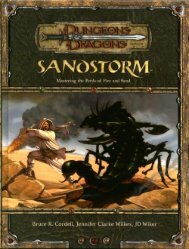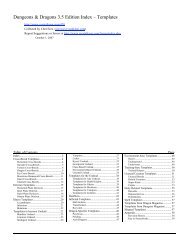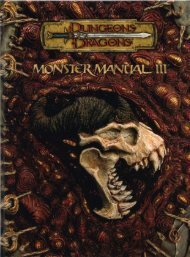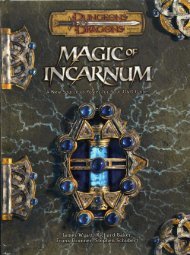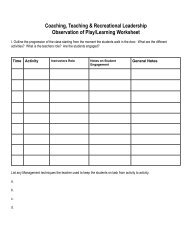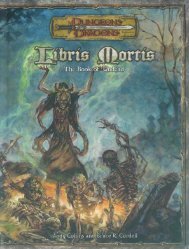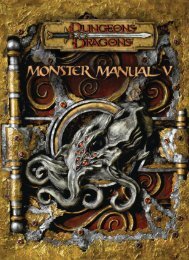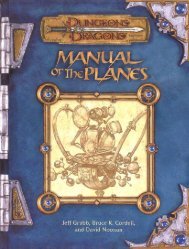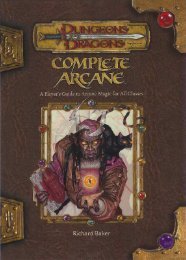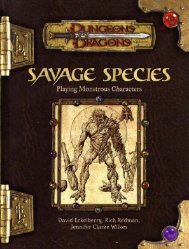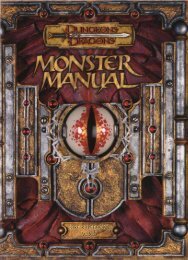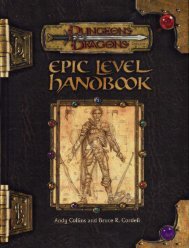Races of Wild
Races of Wild
Races of Wild
- No tags were found...
Create successful ePaper yourself
Turn your PDF publications into a flip-book with our unique Google optimized e-Paper software.
CHAPTER 1ELVES32ELF CITIES ANDSETTLEMENTSElves leave existing settlements to form new ones for a variety<strong>of</strong> reasons, the most common <strong>of</strong> which is sustainability. Elveskeep a very close eye on the resource utilization <strong>of</strong> theirtowns. When the master builder or the guardian <strong>of</strong> naturedecrees that a population has reached the maximum size thatthe nearby resources can support, some <strong>of</strong> its people mustmove on to found a new town.Selection <strong>of</strong> the site for a new settlement is a lengthyprocess involving input from all the prospective settlers.The site must be defensible, have a ready source <strong>of</strong> waterand other resources, and be aesthetically pleasing. The soilshould be fertile and capable <strong>of</strong> supporting a variety <strong>of</strong> plantlife. Ideally, the site should be forested, but elves can alsobuild towns in deserts, plains, and undersea environments.Finally, raw materials for the creation <strong>of</strong> the arts and craftsso essential to elven life should be readily available.A typical elf settlement is described below, as a referencefor DMs looking to design their own and as a location for usein a campaign that features elves.THE ELVEN ECONOMYThe elven economy is driven primarily by mutual giftingand barter. Though gold and silver are just as rare in an elfsociety as they are in any other surface realm, elves rarelyneed currency to buy anything; they make almost everythingthey need themselves. Since one elf may prefer one kind <strong>of</strong>work to another and thus develop more skill with it, they dosometimes barter their skills with other elves so that all canpursue their own passions to the greatest extent possible.Gold, silver, and precious gems are valued for their beauty,though elves do understand the lure that such materials havefor other races and sometimes present them as gifts to cementalliances or thank benefactors outside their race.In addition to trading goods and services with one another,elves frequently present each other with gifts. There is norequirement that an elf who receives a valuable gift mustreciprocate with one <strong>of</strong> equal value, but one <strong>of</strong> equal beautyand workmanship is the norm. No occasion is necessary forexchanging gifts, but festivals, holy days, and impromptucelebrations are common occasions for the exchange <strong>of</strong> giftsbetween friends and loved ones. Elves do not pay taxes, butthey are all equally responsible for maintaining the communitystores. They rarely amass personal fortunes in gold,silver, and other materials <strong>of</strong> value to others, regardless <strong>of</strong>their status within the community.Most elf communities do mint some coins for use intrading with other races, though they are equally willingto barter finished goods with other folk. Elf communitiesmaintain no central treasury, since no elf wants theresponsibility <strong>of</strong> protecting it from those who would covetits contents. Instead, they create coinage only when theyrequire it. A few elves become interested in the numismaticart and produce exceptionally beautiful coins, but most seelittle point in making and hoarding gold in the form <strong>of</strong> coinswhen it could be worked into beautiful jewelry instead. Elvesknow how much gold is in any coin they make, but theyaccept the valuation <strong>of</strong> other cultures rather than imposingtheir own.EXAMPLE SETTLEMENT:WINDINGWATERWindingwater is built in the trees <strong>of</strong> an old forest throughwhich a river cuts a winding path. The soil is rich, and thetrees tower at least 100 feet above the ground. Their bolesmeasure between 6 and 8 feet across, sometimes more.The river widens and narrows, but averages about 20 feetin width and about half that depth. To the east <strong>of</strong> the river isan 80-foot-high bluff. Its existence would be hardly noticeablesince it is lower than most <strong>of</strong> the trees, except for onetowering hollow oak atop it.As with many elf cities, visitors to Windingwater rarelynotice the town until they are inside it. The homes and otherstructures are built high in the trees, and the rope laddersthat provide access to them can be rolled up when not in use.Rope-and-plank bridges connect the various buildings andserve as walkways through the village.A typical tree home consists <strong>of</strong> one or more platformsconnected by ladders. Most have wooden plank walls andceilings that can be retracted to leave various rooms open tothe sky in clear weather. Rooms may be formed by permanentwooden walls or by hanging panels. Paintings, murals, orfrescoes <strong>of</strong>ten decorate interiors.Temple <strong>of</strong> Corellon/Armory: The Temple <strong>of</strong> CorellonLarethian in Windingwater is a platform structure built overthree large trees at the top <strong>of</strong> the bluff. Capable <strong>of</strong> housingthe entire community in an emergency, the temple is stockedwith basic supplies. The worship area is a spacious room witha retractable ceiling and an altar shaped from saelas. (Forinformation about saelas, see <strong>Wild</strong>wood, page 169.) Branches<strong>of</strong> the trees stick up through various portions <strong>of</strong> the floor,and the walls between are decorated with lifelike patterns<strong>of</strong> branches and leaves.One section <strong>of</strong> the temple serves as an armory and a musteringarea for the watch. Bows, arrows, longswords, and variousother weapons are stored here; the junior clerics <strong>of</strong> Corellonkeep them well maintained.The clerics <strong>of</strong> Corellon all have rooms in the temple, butsome also maintain residences in the town. The High Priest<strong>of</strong> Windingwater, Amyn Silverstar, occupies the largest <strong>of</strong>these rooms, and he has decorated it to resemble the skyat dawn.Meeting Area: This large open area just below the bluffis visible only from above. It serves as the location for townmeetings, theatrical events, poetry readings, dances, andother impromptu gatherings. Grass carpets the ground andflowers edge the surrounding trees, despite the many feetthat tread on the area.Ruler’s Dwelling: Panadil Nightbreeze, the King <strong>of</strong>Windingwater, dwells in this large but not ostentatious



